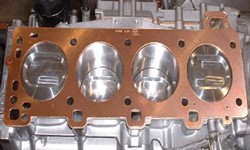Copper gaskets are sealing components made from high-purity copper or copper alloys, designed to create a tight, leak-proof seal between two mating surfaces. They are widely used in industries such as automotive, aerospace, plumbing, and manufacturing due to their excellent thermal conductivity, corrosion resistance, and malleability. These gaskets can withstand extreme temperatures and pressures, making them ideal for applications involving engines, pipelines, and machinery where reliability is critical.
Understanding the specifications of copper gaskets is essential for selecting the right product for your needs. Below, we detail the primary parameters in a list format for clarity.
For a comprehensive overview, refer to the table below summarizing key copper gaskets parameters across common types.
| Parameter | Standard Copper Gasket (C11000) | High-Temp Alloy Gasket (C17200) | Oxygen-Free Copper Gasket (C10100) |
|---|---|---|---|
| Material Composition | 99.9% Copper | Copper with Beryllium Alloy | 99.99% Copper, Oxygen-Free |
| Thickness (mm) | 0.5 - 2.0 | 1.0 - 3.0 | 0.8 - 2.5 |
| Hardness (HRB) | 40 - 60 | 70 - 80 | 35 - 55 |
| Max Temperature (°C) | 250 | 400 | 200 |
| Pressure Rating (psi) | Up to 800 | Up to 1000 | Up to 700 |
| Common Applications | Plumbing, HVAC | Aerospace, High-Performance Engines | Electronics, Vacuum Systems |
Copper gaskets offer numerous benefits that make them a preferred choice in various sectors. Their high thermal conductivity ensures efficient heat dissipation, reducing the risk of overheating in engine and machinery parts. The malleability allows for easy compression and conformability to uneven surfaces, providing a reliable seal even under vibration or thermal expansion. Additionally, copper's natural corrosion resistance prolongs the lifespan of the gasket, especially in harsh environments involving moisture or chemicals. These gaskets are also recyclable, aligning with eco-friendly practices, and their non-sparking properties make them safe for use in explosive atmospheres.
Here are some frequently asked questions to help you better understand copper gaskets and their applications.
What are the main types of copper gaskets available?
Copper gaskets come in several types, including solid copper gaskets, spiral-wound gaskets with copper windings, and copper-clad gaskets. Solid ones are common for high-pressure seals, while spiral-wound versions are used in flanged connections for added flexibility.
How do I choose the right thickness for a copper gasket?
Select the thickness based on the flange gap and pressure requirements; thinner gaskets (0.5-1.0 mm) suit low-pressure applications, while thicker ones (1.5-3.0 mm) are for high-pressure or uneven surfaces. Always refer to manufacturer guidelines or engineering specifications.
Can copper gaskets be reused after installation?
It is not recommended to reuse copper gaskets because they deform upon compression to create a seal. Reusing them may lead to leaks due to loss of elasticity and improper seating. Always replace with a new gasket during maintenance.
Are copper gaskets resistant to all chemicals?
While copper gaskets resist many chemicals, including water, oils, and some acids, they can corrode in environments with ammonia, sulfur compounds, or strong oxidizers. For such cases, consider alloy variants or consult compatibility charts.
What is the typical lifespan of a copper gasket in an automotive engine?
Under normal operating conditions, a copper gasket in an automotive engine can last 50,000 to 100,000 miles, but this varies based on factors like temperature fluctuations, maintenance practices, and engine type. Regular inspections are advised.
How should copper gaskets be stored to maintain quality?
Store copper gaskets in a dry, cool environment away from moisture and direct sunlight to prevent oxidation or tarnishing. Keep them in original packaging or sealed containers to avoid physical damage and contamination.
Do copper gaskets require any special installation techniques?
Yes, ensure mating surfaces are clean, flat, and free of debris. Use a torque wrench to apply even pressure during installation, following the manufacturer's recommended torque sequence to avoid over-tightening and ensure a proper seal.
Are there any alternatives to copper gaskets for high-temperature applications?
Yes, alternatives include graphite gaskets or metal-jacketed gaskets, but copper is often preferred for its balance of conductivity and durability. In extreme temperatures above 400°C, specialized alloys or composite materials might be used.






